#Art Museum eats
Text
Outdoor Spaces: Rodin Garden Bar Returns for Summer 2023
Outdoor Spaces: Rodin Garden Bar @rodinmuseum on the Ben Franklin Pwy Returns for Summer 2023 - check it out!

View On WordPress
0 notes
Text
Man you ever think about how some museums show paintings that aren’t even finished? Like you can see the sketches of people that weren’t painted in but they’re still so beautiful nonetheless, tbh when someone posts their WIPS they never finished and their sketches I hope they know that it’s the same as those paintings on display for people to enjoy and appreciate forever even if it’s not finished, sometimes it just doesn’t have to be it’s complete in it’s own way
#pix habla#ignore me#i just remembered a trip to a museum years ago and noticing the little sketches that were just there behind the paintings#and i would just stare at them for a long time because how lovely is that#the art has so much beauty in it no matter how it ends up looking#-hasn’t been to a museum in literal years-#anyway I’m eating all my friends and mutuals arts and sketches forever
93 notes
·
View notes
Text
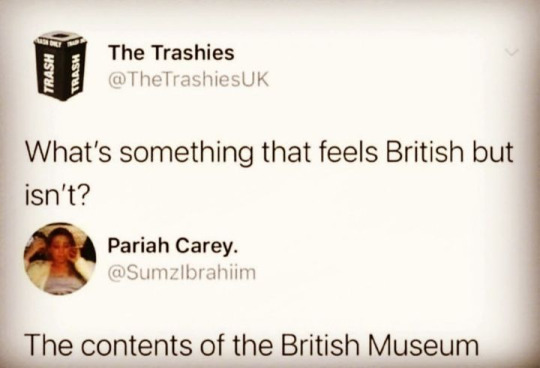
#british gp 2023#british royal family#british columbia#british royalty#british art#british#british museum#museum#united kingdom#uk politics#uk police#uk pop#uk government#uk govt#uk goth#ukpol#ukgov#royalparasites#eat the rich#eat the fucking rich#ausgov#politas#auspol#tasgov#taspol#australia#fuck neoliberals#neoliberal capitalism#anthony albanese#albanese government
69 notes
·
View notes
Text
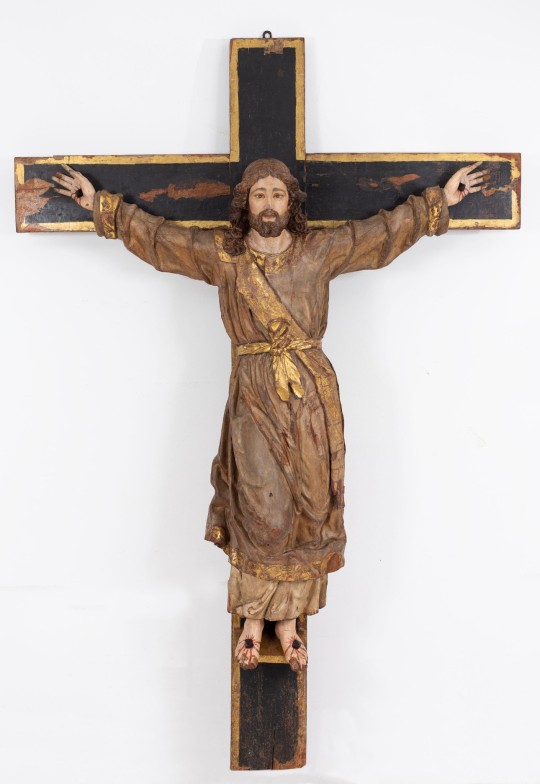
When Catalonia's National Art Museum (MNAC) acquired this piece, they thought it represented Jesus Christ on the cross. On a closer study, they realised it represents a woman: Saint Wilgefortis (Santa Lliberada in Catalan, which means "Saint Liberated").
This wooden sculpture was made by an artist called Andreu Sala around the year 1689 for the church of El Carme in Barcelona, Catalonia. But why does a female saint have a beard? This is not a shock to anyone familiar with this saint's story.
According to the legends, Wilgerfortis was the daughter of a pagan king of Portugal. She converted to Christianity in secret and made a vow of chastity. Her father gave her hand in marriage to a pagan or Moorish king, but she refused to marry anyone. To avoid marriage, she prayed to God to disfigure her to make men find her ugly. God answered her prayers and blessed her by making her grow a beard. The marriage was broken and that made her father angry. He accused Wilgerfortis of witchcraft and had her crucified, like Christ had been.
There are different hypothesis about the origin of this legend:
Some say it might be related to ancient intersex divinities, such as the Ancient Greek Hermaphroditus.
Others say it might have its origin in a side-effect of malnourishment that many nuns had. In convents, it was very common to fast (=not eat for long periods of time for religious reasons), so many nuns had hormonal imbalances that can result in growing facial hair.
The most widespread hypothesis seems to be that Saint Wilgerfortis and similar legends were created to re-interpret the Christs in Majesty that culturally didn't seem male anymore. Because of Byzantine influence, in the Romanesque period (11th-13th centuries), sometimes Christ on the Cross was represented wearing a long tunic tied at the waist and looking calm. After that period, Christ on the Cross was always represented half naked and suffering. They are so different that they look like different saints and the long dress fitted at the waist was associated with women at the time, so people who saw the old representations of Christ would assume it was a woman with a beard, and came up with legends to explain the beard.

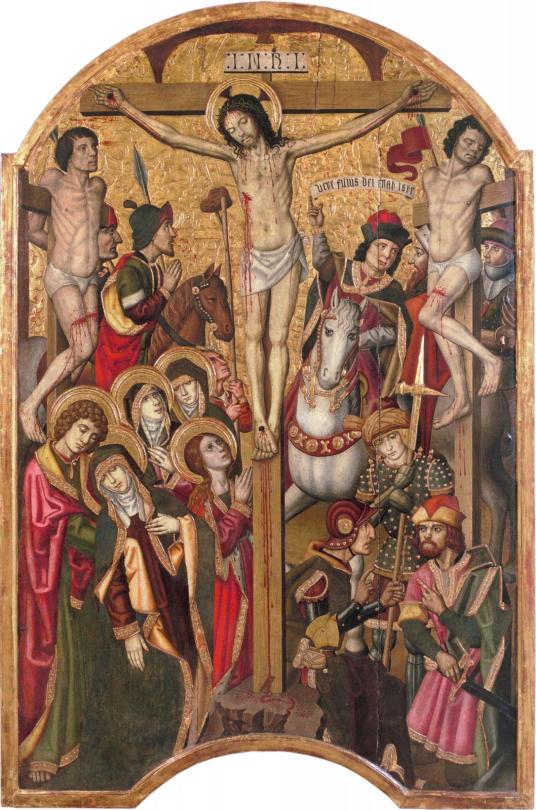
Here you can compare the two ways of representing Christ. On the left, the statue called Majestat Batlló, made in the 1100s in la Garrotxa (Catalonia) in Romanesque style. On the right, the Calvari painting made around 1470 in Granollers (Catalonia). Both of them are kept in MNAC.
There are some other saints with very similar stories to Saint Wilgefortis, like Saint Múnia of Barcelona.
Now you might be wondering, how do we know this statue represents Saint Wilgefortis and not Christ? First of all, this statue is from the Baroque period, where Christ was never represented wearing a long tunic and hadn't been for centuries. Culturally, it would not make any sense for a Catalan artist in the 1600s to represent Christ or any normative man wearing what by then was a woman's dress. Secondly, if you look at the statue from the side, you can see that she has some boobs. And lastly, when the statue was restored, they found a textile fragment at the bottom of the tunic, which was a stitching work made from lace. Traditionally, lace has been a type of decoration used in women’s clothing.
So there is no doubt that this statue, like others that can be found all around Europe, represents Saint Wilgefortis. The woman who was blessed with a beard, and who we call Saint Liberated because her beard liberated her.
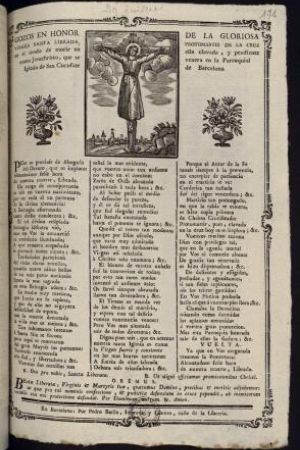

Couplets in honour of Saint Wilgefortis for the church Sant Cugat del Rec in Barcelona, Catalonia. 18th century. Source: Mediateques Montpellier. Here, the images represent her without a beard, but the poem explains her story.
Traditionally, Saint Wilgefortis has been patron saint of agriculture, travellers, children who were stunted or had difficulty walking, skin diseases, pets, laundresses, and the agony of the dying. In more recent times, two more were added: Saint Wilgefortis is the patron saint of transgender people and has been claimed as a lesbian martyr.
Source: Museu Nacional d'Art de Catalunya.
#arts#escultura#uselesslgbtfacts#mnac#baroque#saint wilgefortis#folk saint#trans#transgender#intersex#art history#trans history#museums#museum#history#història#catholiscism#catholic#eating disorder mention#religion
96 notes
·
View notes
Text
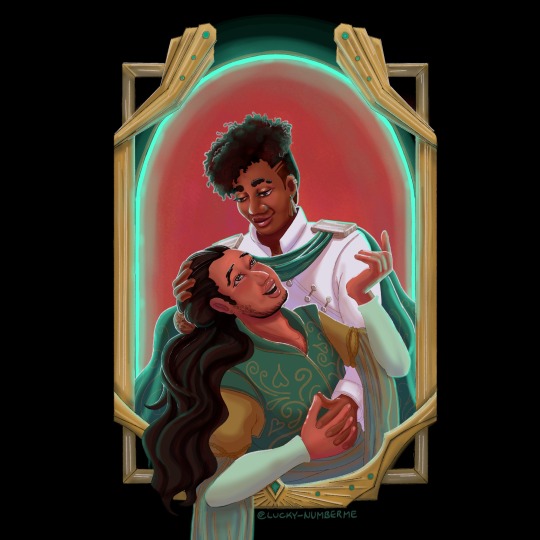
do you think that two space princes in an arranged political marriage coudl on purpose kiss
[ID: A digital portrait of Jainan and Kiem. Jainan leans back against Kiem, who has a hand in his hair. Jainan has a hand raised in a gesture of explanation, and his expression is one of rapturous delight. Kiem looks down at him adoringly. Jainan is wearing sweeping Thean formals, his long hair held back by a wooden gender marker ornament. Kiem is wearing Iskat formals with a Thean cape. He has a wooden earring gender marker. Around them is a glowing frame. End ID]
Queer Book Draw Challenge 6/20 Winter's Orbit by Everina Maxwell (ie @avoliot )
#Tumblr please stop eating this post#the mentals are illnessing lads but the piece is posted#this book (and Ocean's Echo) are both DELIGHTFUL#Could not recommend them more if you enjoy queer genre romance and/or slow-burn. it does all of those things splendidly#winter's orbit#everina maxwell#book art#book fanart#queer books#queer book draw challenge#little museum#Jainan#Kiem#and this next tag's for the old time fans#course of honour
88 notes
·
View notes
Text
not to be tmi but when my ex comes to visit me for an entire week in just a couple of months, y'all will likely get so much ellie x reader content after that cause the similarities between my ex and ellie and the crazy amounts of disgustingly nasty lesbian sex we're gonna be having? the writing inspiration will just be flowing nonstop

#when she came and visited me the first time we literally spent almost an entire day on date wandering around an art museum#it was romantic as FUCK and we were NONSTOP making out and i feel like y'all would eat the fuck up an ellie x reader art museum date fs#my ex is also an artist and her speciality is portraits and her sketchbooks are fuuuuull of sketches of me 🥰#and when we had sex for the first time... sorry but we kind of reinvented lesbian sex it was so hot and nasty i'm w*t just thinking about i#my ex is also a nerdy and very hot muscular butch lesbian who is fucking corny as HELL#ALSO SHE ALSO HAS GREEN EYES BYE LMAO#those fics will write themselves i'm telling y'all now#who wants to donate to my ex's plane ticket fare and our hotel room just think of it as an investment for my future fics#hahahaha jk but what if#sorry i'm just a little obsessed with my ex my bad but y'all love drama anyway otherwise why are you here let's be real#belle speaks#v
68 notes
·
View notes
Photo
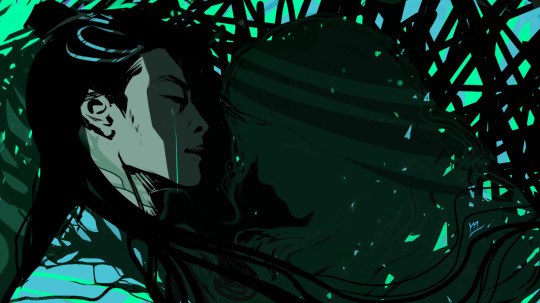
love those episodes where Hwi was like 95%hair❤️
#obviously I am emotionally wrecked#mctna#my country: the new age#seo hwi#nam seon ho#eating glass#still 4 episodes to go I am mentally preparing myself#my art#fanart#woo do hwan’s face belongs in a museum#all museums#museums for his face only#❤️
119 notes
·
View notes
Photo

Don't Eat the Pictures: Sesame Street at the Metropolitan Museum of Art (1983)
#sesame street#don't eat the pictures#grover#super grover#the met#metropolitan museum of art#the met museum#super hero#muppet#knight#muppets#gif#muppet gif#muppets gif#gifs of puppets
116 notes
·
View notes
Text

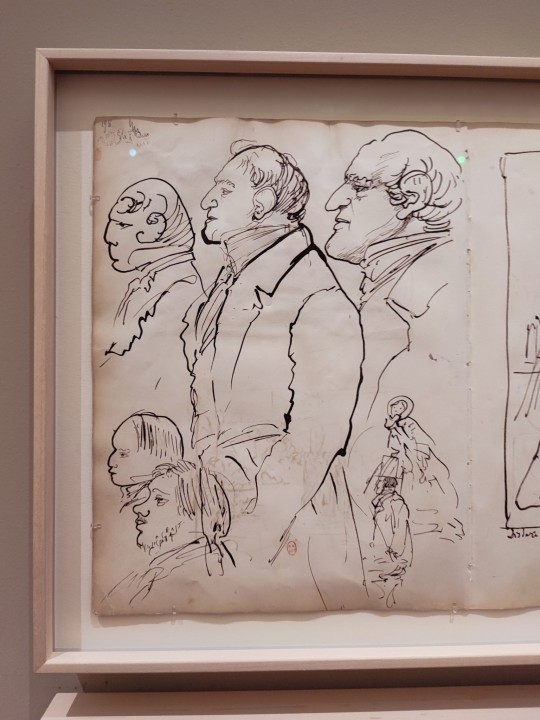




Today's photo dump 📚🖼️
#maybe the key to happiness is visiting museums looking at art and eating good pastries#bnf#bfn richelieu#other stuff#my photo
16 notes
·
View notes
Text
i can’t wait for next friday 🥰 i planned a weekend of events for my bf and myself <3
#gonna take him to an old cars museum after we eat italian food#then we’re gonna go to an art museum and then a place to see a lot of butterflies and flowers and we’ll have a picnic after hehe#after we eat we’re gonna paint :)#i also got him a lil gift hehe
2 notes
·
View notes
Text


Jacob van Hulsdonck, “Still Life with Lemons, Oranges, and a Pomegranate”
#the detail here is so pretty#was ready to eat that pomegranate fr#art#still life#museums#the getty#mine
10 notes
·
View notes
Text
friend we're visiting: y'all hype?? how are you feeling about traveling?
me today: [got up, ate breakfast, sat in the garden and painted in my sketchbook, felt tired and shaky afterward]
#haha I'm in danger :)#I literally just sat in a chair eating breakfast and painting... y'all I am Nervous about camping in the mountains lol#we're not JUST doing that but a lot of the things she threw out there as stuff she wants to show us is still like#'big interactive art installment/ museum you walk around in' or like 'cool places to go shopping'#I'm WORRIED and also I'm FRUSTRATED I wanna do COOL THINGS I wanna HAVE FUN I wanna GO CAMPING#flying for the first time since Before is already gonna be mentally and emotionally taxing just for starters...#I DUNNO I haven't been sleeping enough... maybe today is about coffee and not enough sleep#maybe everything's fine! and I'll get to have fun!! and not spoil anyone else's fun!!#I guess we'll just find out huh!!!#about me
7 notes
·
View notes
Text
The Ultimate Guide to Surviving the Apocalypse: Because Who Wants to Face Judgment Day with An Embarrassing Search History?
Throw in phrases like "radical radiation" and "mega-mutation," and you'll be the coolest cat in the wasteland......
The end of the world is upon us, whether this is at the hands of war-obsessed governments or the rise of the machines it’s time we brace ourselves for impending doom. It’s important to remember that some things never truly disappear – like your embarrassing internet search history.
Whether the apocalypse is brought on by zombies, natural disasters, or the latest Tiktok trend gone wrong, you’ll…

View On WordPress
#Apocalypse survival tips#Art of insect consumption#blog#Building a post-apocalyptic community#Clearing internet search history#Creating a post-apocalyptic dictionary#Documenting survival journey#Eating insects for survival#Entertaining in the apocalypse#Entomophagy benefits#Hosting a radio show for resistance#Invent new slang terms#Karaoke resistance group#Legacy after the apocalypse#Mastering survival skills#Museum of lost internet knowledge#Nerd#Organizing a talent show#Post-apocalyptic cultural hero#Post-apocalyptic etiquette#Post-apocalyptic fashion ideas#Post-apocalyptic lifestyle tips#Preparing for the end of the world#Preserving internet artifacts#Radio broadcasting for survival#Unconventional survival strategies#Writing a post-apocalyptic memoir
6 notes
·
View notes
Text
What's Going On?
Community engagement, yes
the best part about sharing fanart online is I get to read people's thoughts and headcanons. yes please react to my art! ramble in the tags to me! write that reply that's burning on your fingertips! plaster that inappropriate reaction gif underneath! we're not in a museum, eat that banana if you feel compelled to
Anyway, here's the art by tags:
Star Wars
Disco Elysium
Original [still under construction as I need a consistent tag]
#i'm refering to the random museum goers who sometimes end up eating a banana that was The Art#the eating itself is Perfomance Art and I love it#think of the kid who was so moved by an art piece he ate it#yes this is my idea of engaging with art#/periodic art ramble end
8 notes
·
View notes
Text
lapvona semi-quick thoughts
I picked this up at a bookstore 2 weeks ago having barely scanned the summary and reading the first page and a half, drawn in by the pure savagery of the revenge a village reaped on a bandit. thankfully i did not look into any reviews of the book beforehand because i just did now after finishing the book today and ?? i guess people are mad?
tw: sexual violence, general violence, incest, abuse, pretty much all of the stuff
it's pretty uninteresting to call this book gross, and any complaint against it being gross is just...? But one of the repeating charges I've watched/read about this book is that its violence and disgust leads to nothing, is pointless, and generally doesn't seem to send any message. Which is somewhat more of a worthwhile point, but why is it that we demand a message at all? I guess the TLDR of this is that I was fairly entertained by this book, and the tone and style of the writing was so emotionally detached that I never felt the pressure to sympathize with a character, to blink an eye with disaster hit or a major character dies, or be surprised by the book's ending. does this make it a bad book? it depends on what you're reading for. This wasn't the best book I've read by a long shot, but it was a bold, compelling one.
Not interested in talking about religion or feminism or socialism--those themes in the book are extremely on the nose and simplistic, and I think serve more matter-of-factly than to say anything (which is the exact complaint that people have that's fair) illuminating. I haven't dug into any author's notes or interviews but i have heard that Ottessa Moshfegh considers this an apolitical novel, which both makes no sense and a lot of sense at the same time, and might propel me to read more of her commentary on the work. I usually don't like hearing author's notes on their work but this does leave me scratching my head.
What grabbed me the most through this book was the disintegration of the human-animal divide. Ina as a character most obviously embodies this, as someone abandoned by her own kind and survived while blind with the help of birds; her fluency in birdsong, the way she's described as emitting a chirping sound when she sleeps. In the famine she has cannibalized both humans and birds in an attempt to save herself, and at the last leg of the book she manages to regain sight by replacing her own eyeballs with that of a horse's, rendering her part-animal in the flesh.
Marek and Jude both read as the ram described in the beginning--a wretched creature isolated in a pen on its own, unloved and uncared for, who nevertheless does not escape their dreadful life despite the shabby fence that prevents its freedom. Jude also naturally leads to Judas, and then for me to the Judas goat--an animal trained to lead its herd into slaughterhouses. Considering the way Jude and the book at large calls lambs "babes" even more often that it does for human babies, the lambs can be seen as children, or Jude as a sheep, sending his flock off to be eaten every season in tears. And while Lapvona starves and begins to cannibalize each other in the village, up on the hill, Marek cannibalizes his pseudo-siblings by consuming mutton for the first time.
Agata is the character most treated like livestock--chased, bound, and assaulted, mute and named by her captor; I don't even like saying or thinking about her name, knowing that this was a name forced upon her after Jude's mother. In the beginning she was quietly dead, then quietly wedded to Villiam, then quietly dies--there's no struggle there, and she is, along with Lispeth and maybe Dibra, the only characters to empathize with.
Lapvona's villagers all being vegetarians in the onset also mirrors nicely with Jacob being the only named hunter. I don't have much to add with this train of thought except that it's cool!
Anyway. Maybe this is just a personal brain worm. But I think the book cover being a bound lamb really emphasizes the role of the animal in this book to at least rival all of its political, social and class undertones. Taken in that light, this was an interesting read that honestly is not as grotesque as some reviewers say it is, and the grotesque does not need a reason to exist let's just be gross!! 8/10 for this one it was fun. The writing was snappy and kept me turning the pages, the characters' psyches so foreign it felt like I was a tourist in their world, the intertwining and payoff of every character (this was a dense, useful cast) was rewarding, and the ending cruel enough that it feels like its own brand of satisfaction. throw that baby down the mountain!
#books#so did ina eat dibra or NOT and what did ina do to Agata? that's the only thing i'm still restless to know#i think the important takeaway for me is that as with all art it's about your individual visceral reaction to it. what the author intended#or did not intend is not to me of highest priority#you know when you go to an art museum and love a piece and then you read the wall label of their concept and you're like oh :/#if you treated this book like an abstract sculpture or like a performance piece#you will enjoy it more than if you were reading it like an essay looking for a thesis or conclusion
7 notes
·
View notes
Text
life is about getting a little tipsy and almost having a t4t threesome
#life is also about planning girly sleepovers with your friends and eating whipped cream out of the container#and petting your cat and walking in the rain and going to art museums and staring at the naked statues and making obscene comments about#any and everything that portrays crucifixion GRINS#me
2 notes
·
View notes